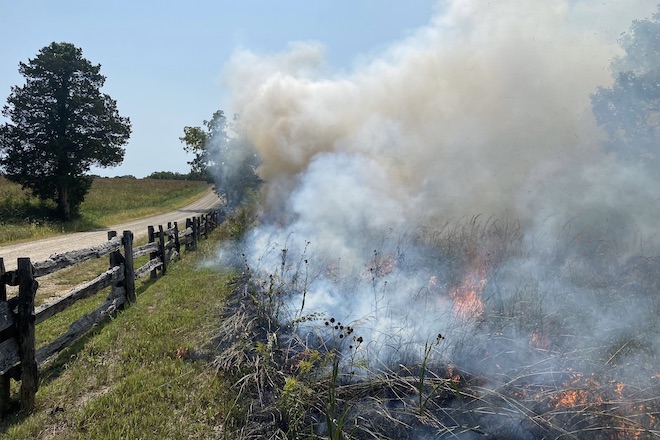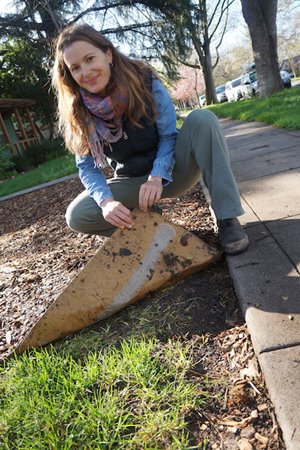Some of the most important work is done in the fall and winter
We typically think of pollinators and monarch habitat in the summer, but most of the work that goes into creating and managing pollinator plots is done during the fall and winter.
There are practices that can be done right now, or in the near future, to prepare and create a wonderful looking pollinator plot for next summer. It’s important to do the work ahead of time so your plot will be perfect for migrating or emerging pollinators in the months to come.
Site Preparation
As we think about pollinator habitat management, we want to start at an important first step — site preparation.
“If you’ve decided you’re ready to plant native habitat on your property, site preparation is the first, and arguably most important step in the process,” said Will Robinson, a Pheasants Forever and Quail Forever Farm Bill wildlife biologist. “Site preparation ensures the ground is ready for your native seeding, and is situationally-dependent.”
If the native seeding will be done on row crop ground, no site preparation will be needed. The seeds can be drilled in, or broadcast on top of the row crop stubble after harvest. Just be sure to use caution with herbicides, as some have a “plant back” date that may affect the native seeding.
Site preparation will require a little more work if the seeding is part of a restoration effort to convert existing cool season grasses (like fescue or brome) to natives. In these cases, it’s imperative the existing cover is killed. This often requires at least two herbicide applications. One can be done in early fall and then a month later a second spraying can be completed. If there isn’t enough regrowth, the second spraying can be done the following spring or the next fall after the natives have gone dormant.
If you plan on broadcasting your seed (scattering either by hand or mechanically over an area), there is one more step. Broadcasting requires mostly bare ground, so the seeds contact soil. Mowing the grasses low before spraying or using prescribed fire is a great way to remove dead material and expose soil — Once complete, you are ready to plant.
Seeding/planting Tips
.jpg.aspx)
After prepping the site and eliminating competing vegetation, the area will be ready for seeding. Depending on the size of the area that will be planted and the equipment available, you can broadcast or drill the native seed mix.
Seeding during the dormant season (fall and early winter) is strongly recommended, as many wildflower species require 30-90 days of cold, moist stratification before germinating. Freezing and thawing during the dormant season will also provide better seed-to-ground contact for increased germination. If seeding is conducted in the spring, some of the seeds may not germinate until the following year.
“Diversity is important when establishing native wildflowers. Plant a mix of at least 20 species that offer a variety of colors and blooms throughout the growing season,” said Farm Bill wildlife biologist Brad Pobst. “Make sure you plant and protect pollinator host plants. Examples include common milkweed, rattlesnake master, wild bergamot, purple coneflower, New England aster, butterfly milkweed, black-eyed Susan, grey-headed coneflower and tickseed coreopsis.”
Managing Habitat

Managing your pollinator habitat over the long-term is key to keeping it in good shape, and prescribed fire is a great tool to use — especially in the fall.
“Prescribed burning can be one of your most useful management tools for pollinator plantings,” said Farm Bill wildlife biologist Emaily Lear. “It’s great for managing high-quality habitat that provides resources for pollinators and other wildlife. Prescribed fire should be used as a long-term management practice and is typically recommended to implement after the second growing season, in order to give forbs a better chance at establishment.”
Prescribed fire can serve different management goals, and can be implemented at different times throughout the year depending on a landowner’s specific objectives.
If the goal is to stimulate native forb growth, fall burning is ideal. Fall burns knock back rank, native warm-season grasses and allow better opportunity for forbs to flourish. This burn period can often hit multiple management targets at once, and also helps control the spread of woody or invasive species. Burning to increase forb diversity is also great for other wildlife, such as bobwhite quail. High forb diversity produces high insect diversity, which is necessary for bobwhite chicks who require a steady diet of high protein, soft-bodied insects early on in their lifecycle.
Urban Gardens
A lot of attention is paid to pollinator habitat on a large scale, but small-scale pollinator plots are also incredibly beneficial. Here are some tips for preparing a site for an urban or suburban pollinator garden.
“If you don't already have a garden area to simply add native pollinator plants to, you'll need to eliminate and remove existing vegetation from your chosen location,” said monarch & pollinator coordinator Donnamarie Duffin. “This ensures they're not outcompeted by invasive species or other non-natives.”
 There are various ways to do this, including traditional use of an herbicide to kill vegetation and "sheet mulching,” which is an herbicide-free option. Sheet mulching uses cardboard to smother turf grass and weeds. Because cardboard is biodegradable, it adds carbon into the soil naturally as it breaks down. Sheet mulching involves several specific steps, which are as follows…
There are various ways to do this, including traditional use of an herbicide to kill vegetation and "sheet mulching,” which is an herbicide-free option. Sheet mulching uses cardboard to smother turf grass and weeds. Because cardboard is biodegradable, it adds carbon into the soil naturally as it breaks down. Sheet mulching involves several specific steps, which are as follows…
First, cut the turf as low as possible, leaving any clippings in the area. Remove any woody plant materials via shovel. Next, soak the area with water and cover with cardboard, ensuring the edges overlap by about six to eight inches. Finally, dampen the cardboard and add four to six inches of mulch on top. Grass clippings or other compost material can be used rather than store-bought mulch if you’d like.
For other suburban garden design ideas, check out these links from Missourians for Monarchs.
-Garden Designs: https://moformonarchs.org/downloads/#garden-designs
-Backyard BMPs: https://moformonarchs.org/wp-content/uploads/2023/09/Backyard_BMP.pdf